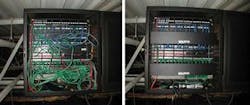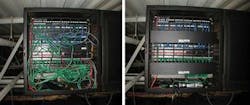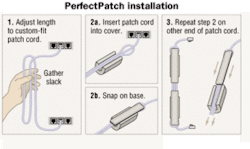Management innovations come to patch cord level
End users today are learning the importance of cable management at the patch-cord level.
They are turning to innovative patch cords and other devices that will help them alleviate the so-called "spaghetti syndrome." These innovations are designed to help users restore order to an out-of-control patching field, or use them to keep such a field from becoming an unmanageable mess.
But for every end user who is taking cable management steps at the patch field level, there are many more who are not. Contractors see it all the time.
"The spaghetti mess is like an epidemic," says Rodney Johnson, owner of Advance Networking Solutions, a cable installation company based in Hopkinsville, KY, referring to the unsightly and confusing mixture of cables leading into many an end user's patch panel.
And the problem is not just cosmetic. An unmanaged and unsightly patching field can cause problems because it takes longer to sort out cables to identify for faults or poor performance. It can likewise lead to confusion during moves, adds and changes (MACs).
But recent cable management advances are addressing these problems. "When you've got a problem area in a cabinet and you clean it up, you will see some improvement," says Johnson.
Some manufacturers are now striving to carve out a cable management niche, coming up with patching field products or patch cord innovations that will open up new layers of management. These new products are designed to keep the patching field clean and ensure that cables don't suffer from an improper bend radius. They eliminate slack problems and help locate cable ends from messy patching fields.
Bending to the standard
Many of the products either deal directly with or accommodate a little-known TIA standard addendum that lowered the acceptable patch cord bend radius. TIA/EIA-568B.1-1 lowered the acceptable patch cord bend radius to 1x the cable's diameter for UTP.
Dennis Mazaris, who worked on the standards committee that developed the addendum, conducted a study on patch cord management that appeared in the February 1997 issue of Cabling Installation & Maintenance. The study indicated that cabling channels do not necessarily suffer performance degradation from tightly bent patch cables. "Any patch panel is a rat's nest, and the cords are already bent," says Mazaris.
The standard still gets mixed reaction today. Regardless of the study's results, Ed Stoneberger, owner of NeatPatch Inc. (www.neatpatch.com), based in Hopkinsville KY, says even a 1x bend is excessive. "I appreciate that they are trying to promote density to a rack, but I don't agree with the 1x radius issue," says Stoneberger. "If you pinch the cable, you are asking for trouble. And a 1x radius is a pinch."
Others counter that the standard makes sense. "We should be fully compliant with it," says Tom Lonsdale, CEO for Cypress Industries Inc. (www.cypressindustries.com), based in Austin, TX.
It is for this reason that today's patch cord management products come down on both sides of the bend radius issue. Some are designed to provide as little bend as possible, easing any pinching to the cords as they provide a means of storing excess slack. Others bend the cable according to the addendum while providing storage space. Some products are simply designed to allow for cable management by helping employees find the ends of patch cords that are lost in a mass of cables.
Neat-Patch
The premier product from NeatPatch Inc. provides a patch-cable storage space that attaches to a rack and enables the customer to store excess patch cable into a neat and tidy compartment. The installer simply coils the excess cable into Neat-Patch and slides it into place in a compartment.The solution's open storage compartment contains vertical wire management units with cable space. These provide deep finger ducts, and allow for cable access through the rear of the unit. They allow the cable to be stored without drastically impacting its bend radius.
"We built a compartment that gets rid of the back wall, and it gives you a neat and available place to store the slack," says Stoneberger. "The wider (the bend), the better the patch cable's chances of performing the job."
Stoneberger says Neat-Patch was designed after he heard many a complaint from end users. One was ThyssenKrupp Corp. (www.thyssenkrupp.com), based in Hopkinsville KY. The automotive manufacturer was seeking answers to ungainly telecom rooms and resulting poor network performance. "It was just a cabling disaster," says Darren Allison, manager of information systems.
Allison says the company was stuffing cables from patch panels into rack finger-duct trays, but the system wasn't working. The plant has a total of 48 network connections, and users were complaining about network speed. IT workers traced the problems back to the bent and pinched cables that were wadded up and stuffed out of the way in the patching field.
Allison says ThyssenKrupp decided to install the Neat-Patch at 21 intermediate crossconnect boxes on the manufacturing plant floor. The system cleaned up the telecom room cable mess, and allowed for a better bend radius for the patch cords. It also made it easier for IT workers to identify cables in the event of MACs. "This gave us the ability to have a clean environment, and to be able to quickly identify the cable if we needed to disconnect a cable or do a crossconnect," says Allison.
Cypress Industries
Other manufacturers are simply concentrating on patch cords. Cypress Industries makes the LED RJ45 Cat5E Patch Cable, which is designed for large networks. It helps increase the speed of upgrades by helping installers or IT workers find cable ends. This solution costs roughly 40% more than a normal patch cord.
But this patch cable isn't designed to help clean up a messy patching field. Instead, it's designed to help end users manage that field. "Just leave them in place," says Lonsdale, referring to the tangle of cables. "With this, you can find the other end easily, even in a rat's nest."
The cable features a custom-molded strain relief that includes an LED that illuminates each end of the cord. Installers or IT managers who are dealing with MACs simply insert a battery unit on either end of the cable, eliminating time-consuming searching and identification.
"What we've found is that when you get into a large networking area, doing a lot of patch cable drops can be a problem," says Lonsdale. "You have to go through and label each cable, and it's time consuming." Lonsdale says this led to the development of his company's patch cable solution. The end result is a patch cord that eliminates the need for tracing the cable through a raceway, and one that could be easily traced to its end.
"It cuts down on the amount of time for adds, drops and changes, and installations, either for a new or existing network," says Lonsdale.
PerfectPatch
PerfectPatch Inc., based in Sterling VA, makes the self-named product PerfectPatch, a device designed to make patch cords adjustable. It eliminates patch cord slack, reduces patch cord inventory and increases network performance. PerfectPatch also helps end users custom fit their patch cords, cleaning up a messy patching field.
"If you have over a football field of excess slack, it causes management problems," says Mazaris, the company's president. "It's unsightly, and there are loose connections that put stress on connectors."
The PerfectPatch is designed to reduce the length of a patch cord by up to 60%, enabling an installer to use the cord more efficiently, and providing a custom fit during installation or following MACs. Installers gather cable slack to adjust its length and custom-fit the patch. They then insert the patch cord into the PerfectPatch cover and snap on its base. This step is repeated on both ends of the cord, and it allows the installer to adjust the cord as if it were sliding on wheels.
The PerfectPatch is designed to be compliant with the bend radius requirements of the 568-B.1-1 addendum.
Kevin Donnelly, whose company, Speed Wire Network Services Inc. (www.speedwireinc.com), based in Floral Park, NY, has installed PerfectPatch, says its puts the onus of cable management into the hands of IT managers who would assist during any MACs. He says that most patching fields start to become messy long after the installer has left the building, and MACs become necessary.
"It's important when leaving the site that it looks beautiful. And a month after that, when the customer starts plugging more cables in, it ensures that it still will look nice," says Donnelly.
Brian Milligan is senior associate editor for Cabling Installation & Maintenance.



